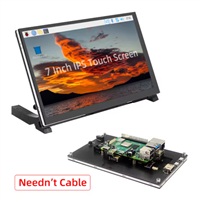|
|
Seeed Studio Wio Terminal |
x 1 |

|
arduino IDEArduino
|
|

|
Soldering Iron Kit |
Wio Terminal Two Channel Scope (Ardiono IDE)
The Wio Terminal is a SAMD51-based microcontroller with Wireless Connectivity compatible with Arduino and MicroPython. It runs at 120MHz , 4MB External Flash and 192KB RAM. The Wio Terminal itself is equipped with a 2.4” LCD Screen, onboard IMU (Acceleromete, Microphone, Buzzer, microSD card slot, Light sensor, and Infrared Emitter. Also it have three buttons, one five way switch (joystick), and reset switch. It supports both Bluetooth and Wi-Fi providing backbone for IoT projects. There is also a 40-pin connector on the back that connects external components and modules.

First I will show you how to connect and install this small but powerful device on Arduino IDE, as well as the basic steps on how to upload a program to it. I hope most readers already have some experience With Arduino, so I will explain this steps briefly.
1. We need to install Arduino IDE software
2. Click on File - Preferences, and copy below url to Additional Boards ManagerURLs:
https://files.seeedstudio.com/arduino/package_seeeduino_boards_index.json
3. Click on Tools - Board - Board Manager and Search Wio Terminal in the Boards Manager.
4. Now in the Tools - Board menu select the Wio Terminal. We can now upload a sketch.

This time I will describe a simple way to turn this device into a small two-channel oscilloscope. An oscilloscope is a highly useful electronic test instrument used for visualizing and analyzing electrical signals over time. It provides a graphical representation of electrical waveforms, making it a crucial tool for engineers, technicians, and scientists working with electronic circuits and systems.
The original firmware was developed for the PIC 24 microcontroller with the built-in high-speed ADC, and the LCD display with a touch panel and can be operated by touching the screen. This is ported version for Woio Terminal, and now the device is controlled through the built-in buttons. The firmware is downloaded from the goji2100 blog, and is in .bin format. Otherwise, the device is extremely simple to make, and in addition to the Vio Terminal, we only need two more connectors for the input signal, specifically I used RCA type connectors. Channel 1 is connected to pin 13 (A0, BCM27) and channel 2 to pin 15 (A1, BCM22) of Vio Terminal, and ground.

Now I will describe the installation method because it is a bit unusual. For this purpose, we need to download the ExtFlashLoader library from the given link:

Then we put a FAT32 formatted micro SD card in the Wio Terminal in which we need to open a folder named "apps" and in that folder we put the given firmware files. Next, we need to install the "ExtFlashLoader" library, and in Arduino IDE, in Examples we need to open the "WriteSampleMenu" sketch. Now we need to install this sketch on Vio Terminal in the way I described earlier in the video.

That completes the installation and we need to start the program. This is done by holding down the A button and restarting the terminal, and then releasing the button. Now the scope is up and running and we can start testing.

The yellow line is channel 1 and the blue line is channel 2. For the sine signal source I will use my old tone generator, and for the other shapes I will use the signal generator contained in my FNIRSI scope.

The signal amplitude of FNIRSI generator is slightly higher than 3.3 V, so the signal is slightly distorted on the lower side, and It is necessary to put a potentiometer or voltage divider at the output of the generator.

The firmware also contains a source of sine and square signals on pins 3 (BCM2) and 11 (BCM17), so if we connect the inputs to these pins, we get corresponding curves on the screen for both channels without using an external signal source. This is a particularly useful option when using the scope for educational purposes.

And finally, a short conclusion: Wio Terminal ADC is not very fast, so this device has almost no practical use, but it is therefore simple, inexpensive, and very good for studying the way this type of instrument works, as well as its adjustment especially because of the extremely professionally made graphic interface. I made a small plastic holder to which the Vio Terminal is attached with the help of two small nuts.
Wio Terminal Two Channel Scope (Ardiono IDE)
- Comments(0)
- Likes(1)
-
 Kenji
Aug 18,2024
Kenji
Aug 18,2024
- 0 USER VOTES
- YOUR VOTE 0.00 0.00
- 1
- 2
- 3
- 4
- 5
- 6
- 7
- 8
- 9
- 10
- 1
- 2
- 3
- 4
- 5
- 6
- 7
- 8
- 9
- 10
- 1
- 2
- 3
- 4
- 5
- 6
- 7
- 8
- 9
- 10
- 1
- 2
- 3
- 4
- 5
- 6
- 7
- 8
- 9
- 10
 More by Mirko Pavleski
More by Mirko Pavleski
-
 Arduino 3D Printed self Balancing Cube
Self-balancing devices are electronic devices that use sensors and motors to keep themselves balanc...
Arduino 3D Printed self Balancing Cube
Self-balancing devices are electronic devices that use sensors and motors to keep themselves balanc...
-
 ESP32 Fluid simulation on 16x16 Led Matrix
Fluid simulation is a way of replicating the movement and behavior of liquids and gases in differen...
ESP32 Fluid simulation on 16x16 Led Matrix
Fluid simulation is a way of replicating the movement and behavior of liquids and gases in differen...
-
 Simple GU50 VTTC Tesla Coil with MOT (25+cm Spark)
Vacuum Tube Tesla Coils are a common choice for homebuilders for several practical reasons. At Soli...
Simple GU50 VTTC Tesla Coil with MOT (25+cm Spark)
Vacuum Tube Tesla Coils are a common choice for homebuilders for several practical reasons. At Soli...
-
 Hourglass ESP8266 Code
A hourglass, also known as an sand clock, is a device used to measure the passage of time. It consi...
Hourglass ESP8266 Code
A hourglass, also known as an sand clock, is a device used to measure the passage of time. It consi...
-
 Tug of War Arduino Game on WS2812 Led strip
A Tug of War is a classic team-based game where two opposing teams compete to pull a rope in opposi...
Tug of War Arduino Game on WS2812 Led strip
A Tug of War is a classic team-based game where two opposing teams compete to pull a rope in opposi...
-
 DIY ESP32 Bioresonance Rife Machine with ZAPPER function
Rife machine therapy is an alternative treatment developed by Dr. Royal Raymond Rife in the 1930s. H...
DIY ESP32 Bioresonance Rife Machine with ZAPPER function
Rife machine therapy is an alternative treatment developed by Dr. Royal Raymond Rife in the 1930s. H...
-
 Arduino VFO Project with a Large LCD Display
A Variable Frequency Oscillator (VFO) is an electronic oscillator whose output frequency can be adj...
Arduino VFO Project with a Large LCD Display
A Variable Frequency Oscillator (VFO) is an electronic oscillator whose output frequency can be adj...
-
 Exploring the Tesla Coil Driver Board, Full Review & Test Results
Some time ago I presented you a video in which I analyzed a super cheap Tesla Coil driver that cost...
Exploring the Tesla Coil Driver Board, Full Review & Test Results
Some time ago I presented you a video in which I analyzed a super cheap Tesla Coil driver that cost...
-
 Arduino Eatrthquake alarm and protection system with D7S seismic Sensor
Earthquakes are extremely common events around the world. On average, there are fifty earthquakes a...
Arduino Eatrthquake alarm and protection system with D7S seismic Sensor
Earthquakes are extremely common events around the world. On average, there are fifty earthquakes a...
-
 Review and Comparison of Three Inexpensive Metal Detector Kits
A metal detector is a device used to detect the presence of metal objects in the ground or other ma...
Review and Comparison of Three Inexpensive Metal Detector Kits
A metal detector is a device used to detect the presence of metal objects in the ground or other ma...
-
 How to make simple Arduino RGB Led strip VU Meter
VU meter or volume unit meter is a device intended for visual presentation of the audio signal. It ...
How to make simple Arduino RGB Led strip VU Meter
VU meter or volume unit meter is a device intended for visual presentation of the audio signal. It ...
-
 DIY Simple Antistress and Relaxation PEMF Device based on Schumannn resonance frequency 7.83 Hz
Schumann resonances are global electromagnetic resonances, generated by lightning discharges in the...
DIY Simple Antistress and Relaxation PEMF Device based on Schumannn resonance frequency 7.83 Hz
Schumann resonances are global electromagnetic resonances, generated by lightning discharges in the...
-
 DIY Si4825 A10 multiband Radio (MW,SW,FM)
Thanks to the production of specialized radio chips, nowadays it is possible to make a quality mult...
DIY Si4825 A10 multiband Radio (MW,SW,FM)
Thanks to the production of specialized radio chips, nowadays it is possible to make a quality mult...
-
 DIY simple HUNTER Led Game with Arduino
Some time ago I presented you a simple to make, but interesting game, a 1D version simulation of "P...
DIY simple HUNTER Led Game with Arduino
Some time ago I presented you a simple to make, but interesting game, a 1D version simulation of "P...
-
 XHDATA D-109WB Radio Short Review with complete disassembly
Recently I received a shipment of a radio from the brand XHDATA model: D-109WB, so I immediately de...
XHDATA D-109WB Radio Short Review with complete disassembly
Recently I received a shipment of a radio from the brand XHDATA model: D-109WB, so I immediately de...
-
 Arduino Rotary encoder combination lock (Arduino door lock system with Rotary Encoder)
Rotary dial safes typically use a mechanical combination lock. They are valued for their simplicity...
Arduino Rotary encoder combination lock (Arduino door lock system with Rotary Encoder)
Rotary dial safes typically use a mechanical combination lock. They are valued for their simplicity...
-
 DIY DRSSTC Music Tesla coil with Interrupter using cheap Driver Module
DRSSTC (Dual resonant solid state tesla coil) is a type of Tesla coil that uses solid-state compone...
DIY DRSSTC Music Tesla coil with Interrupter using cheap Driver Module
DRSSTC (Dual resonant solid state tesla coil) is a type of Tesla coil that uses solid-state compone...
-
 Arduino HPDL1414 Retro Clock with Set and Alarm Functions
The HPDL-1414 is a 16-segment LED display with four printable fields that is over twenty years old....
Arduino HPDL1414 Retro Clock with Set and Alarm Functions
The HPDL-1414 is a 16-segment LED display with four printable fields that is over twenty years old....
-
How to measure weight with Load Cell and HX711
115 0 1 -
-
Instrumentation Input, high impedance with 16 bit 1MSPS ADC for SPI
337 0 0 -
RGB LED Matrix input module for the Framework Laptop 16
559 0 2 -
-
📦 StackBox: Modular MDF Storage Solution 📦
353 0 3 -











































